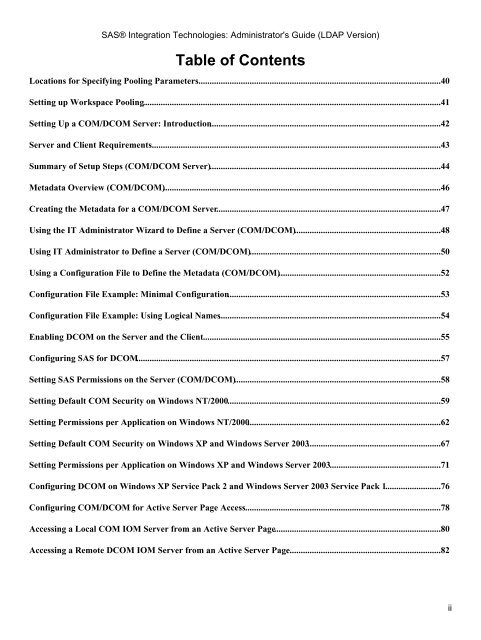SAS® Integration Technologies: Administrator's Guide (LDAP Version)
SAS® Integration Technologies: Administrator's Guide (LDAP Version)
SAS® Integration Technologies: Administrator's Guide (LDAP Version)
You also want an ePaper? Increase the reach of your titles
YUMPU automatically turns print PDFs into web optimized ePapers that Google loves.
<strong>SAS®</strong> <strong>Integration</strong> <strong>Technologies</strong>: <strong>Administrator's</strong> <strong>Guide</strong> (<strong>LDAP</strong> <strong>Version</strong>)<br />
Table of Contents<br />
Locations for Specifying Pooling Parameters.............................................................................................................40<br />
Setting up Workspace Pooling......................................................................................................................................41<br />
Setting Up a COM/DCOM Server: Introduction........................................................................................................42<br />
Server and Client Requirements..................................................................................................................................43<br />
Summary of Setup Steps (COM/DCOM Server)........................................................................................................44<br />
Metadata Overview (COM/DCOM).............................................................................................................................46<br />
Creating the Metadata for a COM/DCOM Server.....................................................................................................47<br />
Using the IT Administrator Wizard to Define a Server (COM/DCOM)..................................................................48<br />
Using IT Administrator to Define a Server (COM/DCOM)......................................................................................50<br />
Using a Configuration File to Define the Metadata (COM/DCOM).........................................................................52<br />
Configuration File Example: Minimal Configuration................................................................................................53<br />
Configuration File Example: Using Logical Names....................................................................................................54<br />
Enabling DCOM on the Server and the Client...........................................................................................................55<br />
Configuring SAS for DCOM.........................................................................................................................................57<br />
Setting SAS Permissions on the Server (COM/DCOM).............................................................................................58<br />
Setting Default COM Security on Windows NT/2000................................................................................................59<br />
Setting Permissions per Application on Windows NT/2000.......................................................................................62<br />
Setting Default COM Security on Windows XP and Windows Server 2003............................................................67<br />
Setting Permissions per Application on Windows XP and Windows Server 2003..................................................71<br />
Configuring DCOM on Windows XP Service Pack 2 and Windows Server 2003 Service Pack 1.........................76<br />
Configuring COM/DCOM for Active Server Page Access........................................................................................78<br />
Accessing a Local COM IOM Server from an Active Server Page...........................................................................80<br />
Accessing a Remote DCOM IOM Server from an Active Server Page....................................................................82<br />
ii
















